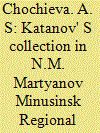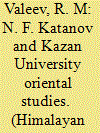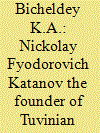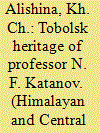| Srl | Item |
| 1 |
ID:
128495


|
|
|
|
|
| Publication |
2013.
|
| Summary/Abstract |
Twelve files, which include the correspondence between N. F. Katanov and N. M. Martyanov, are kept in the archive of Minusinsk Regional museum of local lore'. They give an opportunity to evaluate the contribution of N. F. Katanov to the development of the museum and his interest in his homeland. N. F. KatanOv's letter of 24 January 1894 from Saint Petersburg concerning decoding of Orhon and Yenisei Old Turkic inscriptions is highly characteristic: "Herewith I send my book of script for the museum. Be glad and let all Siberia be glad! In December 1893 Danish researcher W. Thomson and our researcher V. V. Radloff found the most correct key for reading Runic inscriptions. Radloff grew young for 30 years. The script is original, phonetic. About six months ago, Radloff had only guessed and now at the direction of Thomson (with whom he corresponded) and underhis new considerations he learnt to read absolutely fluently. One inscription dates from 738 AD and testifies about Chinese trade with the Arabs and Siberia. . .''.Z
|
|
|
|
|
|
|
|
|
|
|
|
|
|
|
|
| 2 |
ID:
128492


|
|
|
|
|
| Publication |
2013.
|
| Summary/Abstract |
This paper gives an appraisal of Katanov, one of the outstanding founders of Kazan University School of orientalism in the second half of nineteenth and early twentieth centuries. Professor N. F. Katanov is one of the bright and ?amboyant national scholar-thinkers, outstanding representatives of Russian science, education and culture. His life journey and activity reflected important events and tendencies of indigenous and oriental studies. N. F. Katanov's multifarious scientific and pedagogic activity is an unquestionable evidence of great achievements of indigenous orientalism at the turn of nineteenth-twentieth centuries. And his contribution to the development of Kazan oriental studies in this period is indeed invaluable. Since his studentship in Petersburg (1884-1888), his expedition to Southern Siberia and Eastern Turkestan (1889-1892) and tutorage in Kazan (1894-1922), N. F. Katanov's orientalistic activity is connected with complex research of languages, ethnography, folklore and generally spiritual life of the Turkic peoples in Sayan-Altai, Xinjiang, Volga region and Transurals. He had great in?uence on the development of indigenous Turcology in this period.
|
|
|
|
|
|
|
|
|
|
|
|
|
|
|
|
| 3 |
ID:
128488


|
|
|
|
|
| Publication |
2013.
|
| Summary/Abstract |
Actual position of the investigation of this territory was expressed in academician V. V. Radloff's words: "Importance of the investigation of the Turkic tribes' remains in the far east is unquestionable because these
countries have never been visited by experts of the Turkic languages. And we have only odd bits of information collected by outside observers who were not specially prepared for aimobjective".' In 1891 N. F. Katanov was sent by Imperial Saint-Petersburg Academy of Science and Imperial Russian Geographic Society to Eastern Turkestan as the most prepared specialist in the Turkic languages. The investigation of the territory was held in the framework of an investigation project of the Turkic tribes in Eastern Siberia, Mongolia and Northern China to analyse the Turkic tribes' language and household activities. At that time Eastern Turkestan or Uigurstan was a part of China as its northern region - Xinjiang which included Kashgaria (southern part) and Dzungaria (northern part). Population of this region comprised of different Turkic groups: the Turcomen- Uygurs and Kazakhs-Kirghiz worshiping Islam, the Mongolians-Oirats and Chinese Turcomen worshiping Buddhism, etc.
|
|
|
|
|
|
|
|
|
|
|
|
|
|
|
|
| 4 |
ID:
128490


|
|
|
|
|
| Publication |
2013.
|
| Summary/Abstract |
Tuvinian studies is a comparatively new branch in Russian science and represents a set of scientific actions of collective and individual character. In a broader meaning it is a knowledge system about Tuva and the
Tuvinians. Its formation, further development and expansion are connected with the activity of Imperial Russian Geographic Society (IRGS) in the investigation and study of Central Asia in the second half of nineteenth and early twentieth century. The period from 1842 till 1945 can be conditionally called as "the
golden age" of Tuvinian studies. Undoubtedly it was preceded by a range of Tuvinian studies / researches in sixteenth to nineteenth centuries. In this period of history Russian empire strengthened the spread of its
geopolitical interests in Central Asia. Independent explorers and entire expeditions from Russia went to Mongolia, China and Tibet for different purposes including scientific ones. Frequently their pathway ran through the Uryankhai region (one of the former names of Tuva at that time), so explorers and researchers included Uryankhai (Tuva) in the plans of their investigations. Eventually general interest of the Russian empire and its scientific society in Central Asia led to the execution also of special investigations about Tuva.
|
|
|
|
|
|
|
|
|
|
|
|
|
|
|
|
| 5 |
ID:
128480


|
|
|
|
|
| Publication |
2013.
|
| Summary/Abstract |
Scholars of the Tyumen region systematically refer to the scientific heritage of unique scholar-Turcologist Nickolay Fyodorovich Katanov. After his successful graduation from oriental department of Saint Petersburg University in 1889, N. F. Katanov was sent to a long field trip by the Imperial Russian Geographic Society and Petersburg Academy of Science ' to Siberia, Northern Mongolia, Dzungaria and Chinese Turkestan. Here n he studied customs, household activities, language and folklore of the local Turkic peoples besides collecting, processing and preparing huge material for publication. Outstanding orientalist N. F. Katanov enriched indigenous Turcology with extraordinary scientific works concerning the Siberian Tatars. Katanov carried out labour-intensive work in defining and systematizing all proper names that led to the release of two-volume alphabetical index of names which appear in Folk literature samples of the Turkic tribes of V. V.
Radloff. The lion's share of these materials is data on onomastics of the Siberian Tatars.
|
|
|
|
|
|
|
|
|
|
|
|
|
|
|
|
| 6 |
ID:
128499


|
|
|
|
|
| Publication |
2013.
|
| Summary/Abstract |
According to S. E. Malov's division of the Turkic languages, the Khakass language is old. It preserved Old Turkic roots in unchanged form and includes those which led to the development of verbal forms. That is why the study of Khakass lexis and especially verbal lexis is of apparent interest for a Turcologist. In this work there is the analysis of Khakass verbal lexis of the late 19th century contained in a comparative framework with material of the modern Khakass language. The first part of N. F. Katanov's work The Tatar language (the Sagay dialect) includes grammar (etymology and syntax). The second part is devoted to a corpus of examples and Sagay-Russian dictionary. This work contains more than 800 Copybook sheets. N ickolay Fyodorovich was preparing it during his study at Krasnoyarsk classic high school. He finished it in 1884. The work is still unpublished. It is invaluable for the dialectology and history of the Khakass language.
|
|
|
|
|
|
|
|
|
|
|
|
|
|
|
|